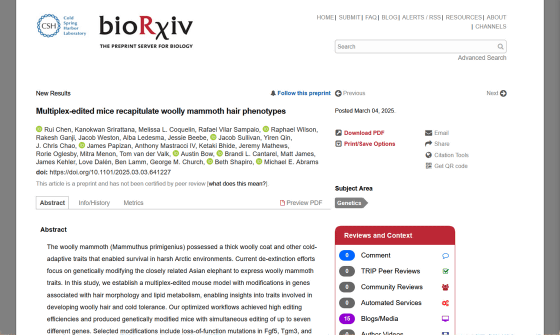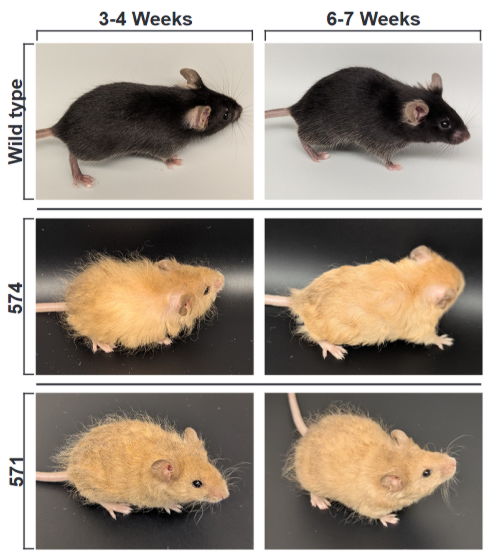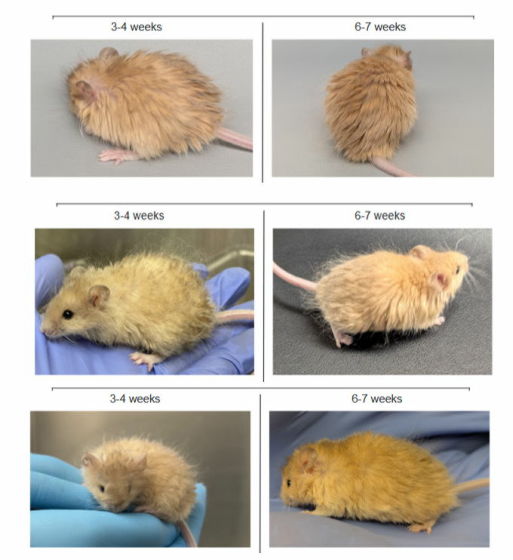A company aiming to resurrect a mammoth has announced it has created a fluffy, long-haired mouse

Multiplex-edited mice recapitulate woolly mammoth hair phenotypes | bioRxiv
https://www.biorxiv.org/content/10.1101/2025.03.03.641227v1

“Wooly mice” a test run for mammoth gene editing - Ars Technica
https://arstechnica.com/science/2025/03/wooly-mice-a-test-run-for-mammoth-gene-editing/
These Woolly Mice Bring The Mammoth's De-Extinction a Step Closer : ScienceAlert
https://www.sciencealert.com/these-woolly-mice-bring-the-mammoths-de-extinction-a-step-closer
Colossal's mammoth resurrection project focuses on genetically modifying the Asian elephant , the woolly mammoth's closest genetic relative, to give it traits like hairy bodies and abundant fat reserves.
However, Asian elephants have a long gestation period of 22 months, so it would take too long to actually use Asian elephant embryos for genetic engineering experiments. In addition, Asian elephants have complex social structures and high cognitive abilities, and Asian elephants themselves are an endangered species, so it would be ethically difficult to conduct experiments on them.
The Colossal team conducted a new genetic modification experiment using mice. They analyzed 59 genomes from woolly mammoths, steppe mammoths (Trogonthey's mammoths) , and Colombian mammoths that lived between 1.2 million and 3,500 years ago, and investigated the differences between the genomes of Asian elephants.

By
This allowed the research team to identify 'mammoth genes' that were clearly different from those of Asian elephants, and from these they elucidated seven genes related to the woolly mammoth's long fur, as well as genes that alter fat metabolism.
The team then used three different gene editing techniques to introduce the woolly mammoth mutations into mouse embryos. The team's optimized workflow allowed them to achieve high gene editing efficiency and edit up to seven different genes simultaneously.
Mice that had been introduced with the gene mutation found in woolly mammoths showed some notable changes that were different from their parent mice. In the image below, the top one is a wild-type mouse that had not been genetically edited, while the middle and bottom ones are genetically modified mice that had been genetically edited in slightly different ways. You can see that the genetically modified mice have long, golden hair with a characteristic wavy texture.

The genetically modified mice's hair was up to three times longer than that of wild mice and was characteristically wavy and curly.

The research team named the genetically modified mouse they created 'Colossal Woolly Mouse.' Ben Lamb, co-founder and CEO of Colossal, said, 'The Colossal Woolly Mouse is a turning point in our mission to revive extinct species. By engineering multiple cold-tolerance traits from the mammoth's evolutionary path into a living model species, we have demonstrated our ability to reproduce the complex genetic combinations that nature created over millions of years. This success brings us one step closer to our goal of reviving the woolly mammoth.'
However, according to technology media Ars Technica, most of the gene mutations had been found in mice in the past, and there is little connection between the Colossal Woolly Mouse and the woolly mammoth. Although editing multiple genes at once with a relatively high editing efficiency is certainly an impressive technical achievement, they pointed out that we are still far from our ultimate goal.
Related Posts:







